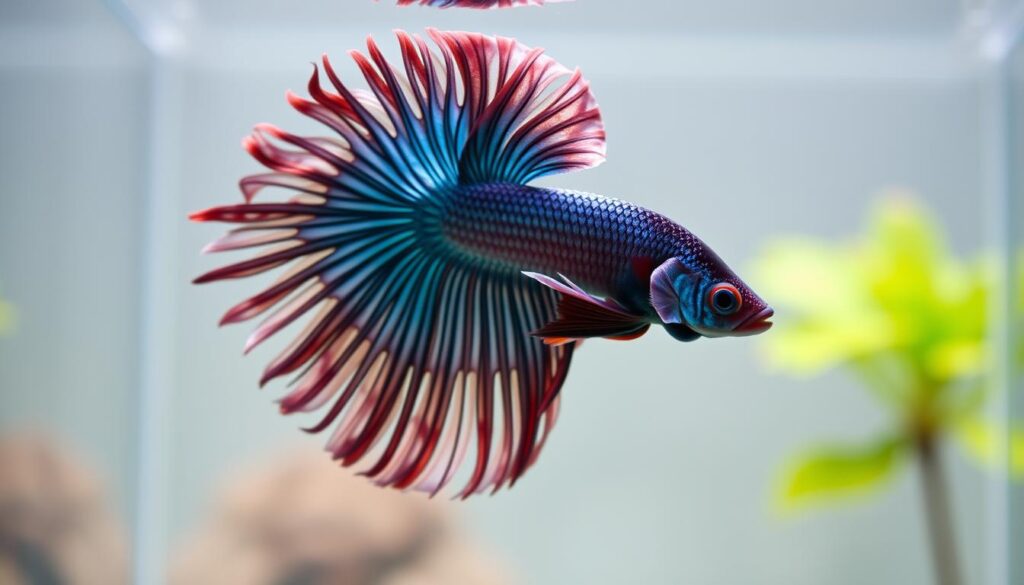Crowntail Betta Fin Rot is a common yet serious condition that can affect the beautiful flowing fins of your Betta. If left untreated, it can lead to severe damage and even health complications. This condition is usually caused by poor water quality, bacterial infections, or stress. In this guide, we’ll explore the causes, symptoms, and effective treatments to help your Crowntail Betta recover and stay healthy. Identifying symptoms early is crucial when treating fin rot in bettas. It starts with discoloration and can lead to complete fin rot and infection. By understanding the causes and following our care tips, you can prevent fin rot and ensure your crowntail betta thrives.
Key Takeaways
- Fin rot is a common issue in betta fish, affecting around 20-30% of fishkeepers.
- Poor water quality and stress are the leading causes of fin rot in crowntail betta fish.
- Early detection and treatment are crucial to preventing the progression of fin rot.
- Regular maintenance and proper care routines can help prevent fin rot in betta fish.
- Treating fin rot in bettas requires a combination of good water quality, proper nutrition, and effective treatment options.
- By following these betta fish care tips, you can help keep your crowntail betta healthy and thriving.
- Remember, fin rot can be treated and prevented with the right knowledge and care, so don’t hesitate to reach out if you have any questions about crowntail betta fish fin rot.
Understanding Crowntail Betta Fish Fin Rot
Wondering about fin rot and its impact on your crowntail betta fish? Fin rot is a common disease that harms betta fish fins. It can lead to serious health problems. Knowing the causes and signs of fin rot is crucial for your fish’s care.
Spotting fin rot early is key. It’s caused by bad water or stress. Look for frayed fins, color changes, or hard breathing. Testing the water often helps keep your betta healthy.
Here are important tips for crowntail betta health and fin rot prevention:
- Regular water changes (20-25% weekly) to maintain optimal water quality
- Providing a suitable environment, including a minimum tank size of 5 gallons and temperatures between 76-80°F
- Monitoring your fish’s behavior and watching for signs of stress or disease
Understanding fin rot helps protect your crowntail betta. Early detection and care are vital for your fish’s well-being.
| Factor | Importance |
|---|---|
| Water Quality | High |
| Stress Levels | Medium |
| Genetics | Low |
Early Warning Signs of Fin Rot in Bettas
Hey there, betta owners! We’re here to help you spot the early signs of fin rot in your fish. Catching fin rot early is key to treating it. Look out for tail and fin tips that are black or red – these could be signs of fin rot.
It’s important to watch your betta’s health closely for fin rot treatment. Here are some common signs to look for:
- Deteriorating tail and fin tips with black or red edges
- Brownish fin edges and jagged tips
- Shredded fins with small holes
By catching these signs early, you can treat fin rot in bettas. Remember, acting fast is crucial for a successful recovery. Keep a close eye on your betta’s fins. With the right care, your fish can get better and live happily in their tank!

Common Causes of Fin Rot in Crowntail Bettas
So, what causes fin rot in Crowntail Bettas? The answer is complex, and knowing the causes is key. As part of crowntail betta fish care, it’s important to understand fin rot causes. These include poor water quality, stress, bacterial infections, and physical damage. By knowing these causes, you can prevent fin rot and keep your betta fish healthy.
Some of the main factors that lead to fin rot include:
- Poor water quality: This is a common cause of fin rot. Keeping the water clean is crucial through regular changes and good filtration.
- Stress factors: Stress weakens your betta’s immune system, making them more prone to disease. To prevent fin rot, it’s vital to create a comfortable and stable environment.
- Bacterial infections: These can cause fin rot. It’s important to prevent them by keeping the water quality high and avoiding overcrowding.
- Physical damage: Damage to the fins can also lead to fin rot. It’s essential to provide a safe and comfortable space to prevent this.
By following these betta fish care tips, you can prevent fin rot and ensure your betta fish stays healthy. Always keep the water quality high, reduce stress, and prevent bacterial infections and physical damage.
Read Also How Often Do I Feed My Betta Fish? Simple Feeding Tips

Identifying Different Stages of Fin Rot
Understanding the stages of fin rot in bettas is key. As a betta fish health lover, you aim to care for your pet well. Fin rot can vary from mild to severe, and knowing the stage helps in choosing the right treatment.
Here are the different stages of fin rot:
- Mild: fins may look milky at the edges
- Moderate: fins may start to fall off, showing ragged edges
- Severe: fins and/or tail can completely disappear, which is very dangerous
To stop fin rot, keeping water quality high is vital. A clean tank and a balanced diet are also important. These steps can help prevent fin rot.
Knowing how to spot fin rot and taking steps to prevent it can keep your betta fish healthy. Remember, diagnosing fin rot in bettas needs careful attention and a strong commitment to your pet’s care.
| Stage of Fin Rot | Symptoms | Treatment |
|---|---|---|
| Mild | Discoloration of fins | Antibiotics, improved water quality |
| Moderate | Detached fin pieces, ragged edges | Antibiotics, improved water quality, fin repair |
| Severe | Complete loss of fins and/or tail | Aggressive treatment, hospital tank, close monitoring |
Essential Water Parameters for Healthy Crowntail Bettas
For crowntail betta fish care, keeping water parameters right is key. You need to mimic their natural home. This means focusing on temperature, pH, and ammonia and nitrate levels.
To keep your Crowntail Betta well, the water should be between 76-82°F (24-28°C). This range is crucial to avoid fin rot. Also, keep the pH between 6.5-7.5, which is slightly acidic to neutral.
For betta fish care tips, watch the ammonia and nitrate levels closely. These should be as close to zero as possible. Regular water changes (about 25-50% per week) help keep the water right and prevent fin rot.

By following these tips and keeping an eye on water quality, you can ensure your Crowntail Betta stays healthy. Remember, preventing fin rot in bettas is about creating a stable, comfy home. With the right care, your fish can live a long, happy life.
Read Also Why Does My Betta Fish Keep Staring at Me? The Surprising Reasons You Need to Know!
Effective Treatment Options for Betta Fin Rot
So, you’ve found fin rot in your betta – now what? Treating fin rot in bettas needs a careful plan. We’re here to help you through it! For mild cases, start with 1 teaspoon of aquarium salt per gallon of water. For more serious cases, you might need up to 3 teaspoons per gallon.
Keeping the water temperature right is key. Aim for 76-78°F. This stops bacteria from growing too much. Also, do daily 100% water changes in the quarantine tank for both mild and major cases.

Important things to remember when treating fin rot include:
* Use aquarium salt for no more than 10 days to avoid harming your fish’s kidneys and liver
* Don’t use aquarium salt for too long, as it can make diseases resistant to treatment
* Watch your betta closely and change the treatment plan if needed
By following these steps and being careful, you can help your betta get better. Always put your betta’s health first. If you’re not sure what to do, get professional help.
Natural Remedies vs. Medication
When treating crowntail betta fish health issues like fin rot, we often debate natural remedies or medication. The choice depends on the disease’s severity and your fish’s needs. It’s important to diagnose fin rot accurately to choose the right treatment. Natural remedies can treat fin rot, but sometimes, medication is needed.
Natural treatments include aquarium salt, water changes, and keeping water parameters right. For mild fin rot, 1 tsp of aquarium salt per gallon can help. But, for severe cases, antibiotics like Maracyn II or API Fungus Cure might be required. Always follow the dosage instructions to avoid antibiotic resistance.
Here are some key considerations when choosing between natural remedies and medication:
- Natural remedies can be effective for mild cases of fin rot
- Medication may be necessary for more severe cases or when natural remedies are not effective
- Regular water changes and maintaining optimal water parameters are crucial for preventing fin rot and promoting crowntail betta fish health
In conclusion, the choice between natural remedies and medication depends on your fish’s needs and the disease’s severity. Understanding the pros and cons of each method helps you make the best decision for your pet’s health.
| Treatment Method | Effectiveness | Risks |
|---|---|---|
| Natural Remedies | Effective for mild cases | May not be effective for severe cases |
| Medication | Effective for severe cases | Risk of antibiotic resistance |
Recovery Timeline and Monitoring Progress
When treating fin rot in bettas, it’s key to watch your fish closely. Recovery from fin rot takes time, so patience is important. You’ve already started by noticing symptoms and beginning treatment.
Every fish recovers differently, based on the fin rot’s severity and treatment success. Some betta fish get better fast, while others take longer. It’s crucial to observe your fish’s progress and tweak the treatment if needed.
Here are some tips to track your fish’s recovery:
* Keep a record of symptoms, treatment, and progress
* Take regular photos to see changes in appearance
* Watch your fish’s appetite, energy, and behavior
* Adjust the treatment plan based on your fish’s response
By following these tips and caring for your fish, you can help them recover from fin rot. Remember, recovery takes time, and don’t hesitate to ask for help if you need it.
Read Also 10 Common Betta Fish Health Problems & How to Treat Them
Preventing Future Fin Rot Outbreaks
Great job treating your crowntail betta’s fin rot! Now, let’s work on preventing it from happening again. Keeping your fish healthy is a big deal, and we’re here to help. To stop fin rot, you need to keep up with regular care, improve their environment, and feed them right. Follow these easy tips to lower the chance of fin rot and keep your betta happy.
First off, regular care is crucial. This means changing the water weekly, cleaning the tank, and checking the water quality. You can also add plants or toys to reduce stress and give your betta places to hide. And, a good diet is key to keeping your betta strong. By following these betta fish care tips, you can prevent fin rot and keep your crowntail betta healthy and happy.
- Providing a healthy and balanced diet
- Avoiding overpopulation and aggressive tank mates
- Maintaining proper pH balance and water quality
- Regularly testing for ammonia and nitrate levels
By following these simple tips and keeping up with yourcrowntail betta fish care, you can prevent fin rot. Remember, preventing fin rot is all about creating a healthy and happy home for your betta. With these tips, you can do just that!
When to Seek Professional Help
As a responsible pet owner, knowing when to seek help for your crowntail betta fish is key. If you’re not sure about the diagnosis or your fish’s health gets worse, get expert advice. A vet or aquarium expert can spot common diseases like fin rot and guide you on how to treat it.
Some signs you need professional help include:
- Severe discoloration or deterioration of your betta’s fins
- Signs of necrosis or tissue damage
- Lack of response to treatment or worsening condition
Crowntail betta fish health is delicate, and diseases can spread fast. If you’re unsure about your fish’s health or how to diagnose fin rot, don’t wait. A vet or aquarium expert can help you keep your betta fish healthy and happy.
Getting professional help when needed is crucial. It ensures the best care for your crowntail betta fish and prevents diseases like fin rot from getting worse.
Conclusion of Crowntail Betta Fin Rot
Well, there you have it – everything you need to know about keeping your crowntail betta fish happy and healthy, even when dealing with fin rot. By following the tips and tricks outlined in this comprehensive guide, you’ll be well on your way to maintaining a thriving aquatic companion.
Remember, prevention is key when it comes to treating fin rot in bettas. Stay on top of water quality, provide a stress-free environment, and act quickly at the first signs of trouble. With a little bit of diligence and the right betta fish care tips, you can help your crowntail bounce back to their vibrant, full-finned glory.
So, what are you waiting for? Get out there, put your newfound knowledge to the test, and let us know how your crowntail betta fish is doing. We’re always here to lend a helping hand and celebrate your fishy friend’s successes. Happy fishkeeping, folks!

